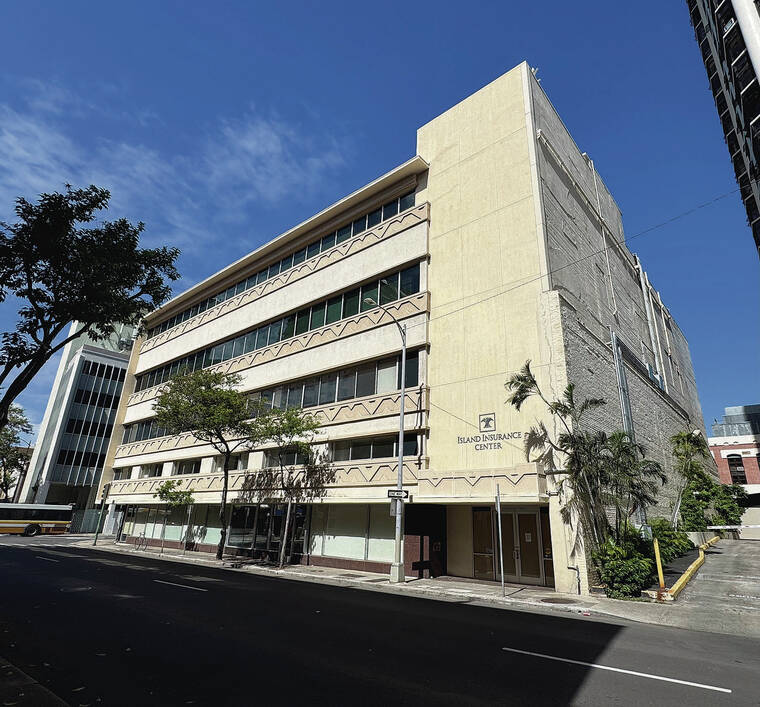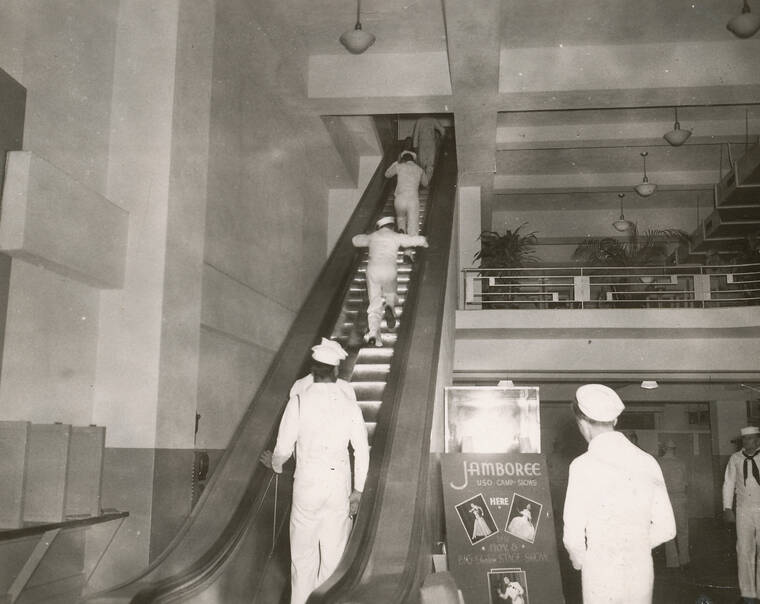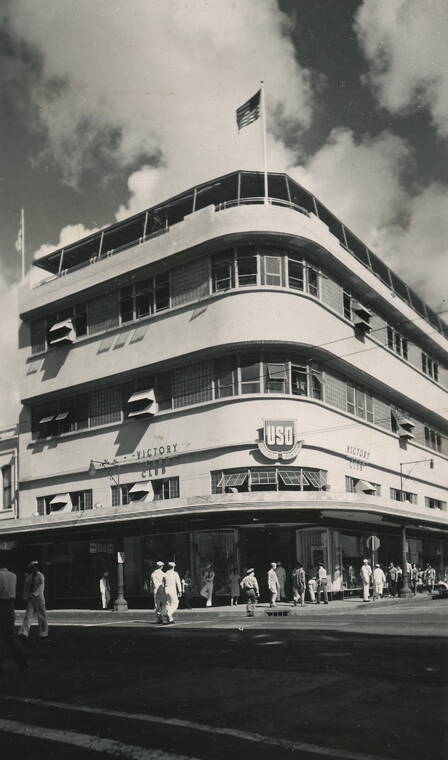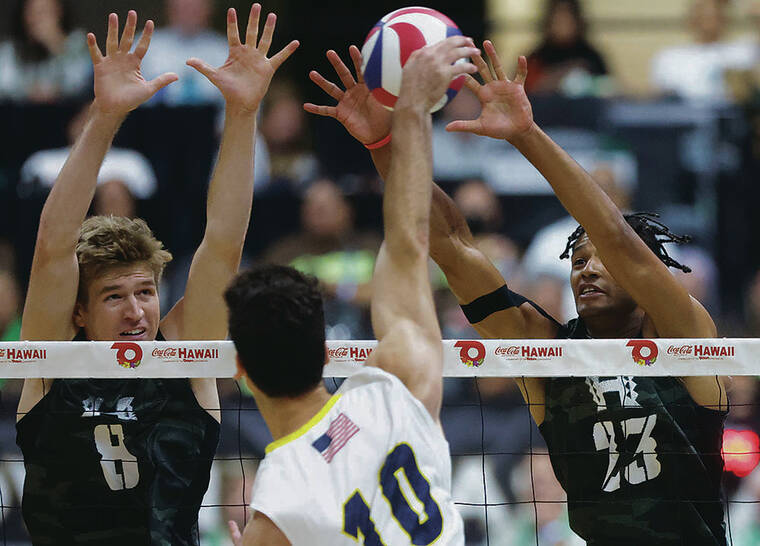Rearview Mirror: Downtown building once Japanese store, USO club

COURTESY BOB SIGALL
The building above, on the Ewa-mauka corner of Bethel and King streets, was the House of Mitsukoshi, a Japanese department store in 1940.

STAR-ADVERTISER
Canlis’ Charcoal Broiler was one of the top restaurants in Hawaii from 1947 to 1989.

STAR-ADVERTISER
House of Mitsukoshi, a Japanese department store in 1940, became the USO Victory Club during World War II, serving over 3,100,000 service men and women in its first year. It also featured the first escalator in Hawaii.

STAR-ADVERTISER
House of Mitsukoshi, a Japanese department store in 1940, became the USO Victory Club during World War II, serving over 3,100,000 service men and women in its first year.




On the Ewa-mauka corner of 1022 Bethel and King streets downtown is a five-story building that Island Insurance occupied until 2024. Across the street, on the Diamond Head side of that corner, was Liberty House, then Macy’s and Walmart, from the 1850s to today.
Bethel Street is named for the Seamen’s Bethel Church, founded in 1833 near the intersection of today’s Bethel and King streets. “Beth” means “house,” in Hebrew and “el” means “God.” Today the church is known as Central Union Church.
Amateur historian Linda Louie knows I am always interested in what occupied particular locations in the past. She told me a little about the history of the Island Insurance building, which turned out to be fascinating. I discovered that one of Hawaii’s top restaurateurs got his start there.
House of Mitsukoshi
Several young, local Japanese men opened a Japanese department store on that site in 1940. Mitsukoshi was the largest Japanese department store chain in Asia.
The House of Mitsukoshi had the first (one-way) escalator in Hawaii. It was installed on Dec. 21, 1940. Young people and adults thronged the new store to ride its escalator.
Don't miss out on what's happening!
Stay in touch with breaking news, as it happens, conveniently in your email inbox. It's FREE!
The downtown store sold kimonos, silk goods, footwear, clothing, groceries, sporting goods, furniture and art. It was three stories tall, plus a basement and a rooftop garden cafe.
“It was owned by local investors,” Louie said. “After the December 7, 1941, attack, the general public stopped shopping there. The owners put an ad in the papers telling residents that they, too, were local, loyal island residents.
“All stock in this firm is owned by island people, and the American business methods and merchandise employed by the firm have earned for it an increasing patronage from the people of the territory.”
With America at war with Japan, it didn’t help, and after only 14 months in business, the House of Mitsukoshi was gone.
USO
World War II brought thousands of men and women to Hawaii. Taking care of their off-duty recreational needs were 48 USOs in Hawaii.
The largest was the Army & Navy YMCA downtown on Hotel and Richards streets. It had been the Royal Hawaiian Hotel and is now the Capitol Modern (formerly called the Hawai‘i State Art Museum).
The YMCA was a co-founder of the USO, which sought to be the GIs’ “home away from home.”
Victory Club
The USO took over the Mitsukoshi store and turned it into the USO Victory Club. It opened in 1943 with a dormitory, post office, game room, writing and lounge rooms, cafeteria and soda fountain.
It put on dances, stage shows, musical events and art exhibits. Over 3,100,000 service men and women enjoyed its facilities in its first year. More than 53,000 used its sleeping accommodations, and 820,000 dined there.
For the Victory Club’s first anniversary, a huge cake was baked in 50 pans and transported to the Victory Club. Two men spent 2-1/2 hours icing it into a masterpiece that was 14 feet long, 2 feet wide and 8 inches high. Service men and women devoured it in 45 minutes.
Peter Canlis
Who was in charge of food and beverage for the Victory Club as well as the Army & Navy YMCA? A 28-year-old man named Peter Canlis.
Canlis’ parents were from Lebanon. They owned the Food Palace restaurant in Stockton, Calif., in 1936. Their son hated working there as a teenager and got a job selling tablecloths and linens in Hawaii in 1941. One of his customers was the Army & Navy YMCA. He sometimes dined there and complained about the mediocre food.
On Dec. 8, 1941, he lost his sales job, but the manager offered him a new one. “You’ve been squawking about our food, now you take over the restaurant.”
Canlis headed for the USO’s kitchen. Within a year he was serving 3,500 meals a day to ravenous soldiers and sailors. When the Victory Club opened, Canlis was put in charge of feeding its service personnel, too.
A popular breakfast with military personnel was three eggs, cooked to order, ham, pancakes and a quart of milk for $2.
For lunch and dinner, Canlis provided such tasty edibles as barbecued steak sandwiches, toasted cheese sandwiches, turkey sandwiches, “pigs in blankets” and spaghetti and meatballs.
Honolulu Advertiser editor Aaron “Buck” Buchwach said he first met Canlis in 1945 on Thanksgiving Day. At the time, he was city editor of the Pacific Stars and Stripes newspaper.
“This gruff voice on the phone identified himself and asked, in what I learned was his usual warm style, ‘Why in hell doesn’t the Stars and Stripes send a photographer down to the YMCA and see just how good we treat GIs for a buck a person?’
“It was Thanksgiving and we were off duty, so a GI buddy and I walked into the YMCA. We were overwhelmed. It looked like the Monarch Room of the Royal Hawaiian, only better,” Buchwach said.
“Red tablecloths, white napkins, gleaming silver, soft lighting and four ice carvings of geese and turkeys. The food was magnificent. Before too long, Canlis told me, he was going to open a restaurant in Waikiki.”
End of the war
A parade was held in September 1945 celebrating our Victory Over Japan (V-J) Day. Thousands of GIs came to see it. “We didn’t know whether Honolulu restaurants would remain open that day,” said Canlis, “but we weren’t going to have any guy in uniform go hungry on a day like that.”
A 35-by-50-foot tent was erected at the Army & Navy YMCA. The staff dispensed 25,000 roast beef sandwiches, 3,000 gallons of punch and 5,000 ice cream cups, all free. By late afternoon all that was left was a battlefield of discarded sandwich wrappers and crushed paper cups.
Served 4.5M meals
After the war the Veterans Administration took over the Victory USO Club building, followed by Aloha Airlines, International Savings & Loan and City Bank. Island Insurance was there until 2024. Today it’s empty and rumored to become a storage facility.
In May 1946, Canlis took his first vacation in six years to visit his wife and 7-year-old daughter in New York City. It was estimated that he and his staff served 4.5 million meals during WWII.
In 1947, Canlis opened The Broiler at 2416 Kalakaua Ave., where the Hyatt Regency is today. Its sign hung from a coconut tree. Seven years later it moved to 2100 Kalakaua Ave. and Kalaimoku Street. Luxury Row is there today.
Canlis’ female servers wore kimonos. They apprenticed for over a year to learn to prepare the famous Canlis’ Salad tableside, as well as other tasks.
The salad recipe was so popular it ran in newspapers all over their world, and many mainland restaurants listed Canlis’ Salad on their menus.
Ed Sheehan, who was his press agent for 15 years, said of Canlis: “Nothing was partway with him. He wanted the very best of everything.
“He was a guy who liked the best in food and clothes. This town owes him something because he kept a lot of people on their toes trying to keep up with him. Canlis was a man of very, very good taste.”
One of his maitre d’s was a young man named Buzz Schneider. He left to start his own chain of Buzz’s restaurants — fine dining but in a casual setting. Many copied that formula.
Canlis opened other locations, including in San Francisco, Portland, Ore., and Seattle, which is still in business.
Canlis died from lung cancer in 1977 at age 64. His Waikiki restaurant closed in 1988 after serving over 3 million meals.
When I polled readers in 2024 for their favorite gone-but-not-forgotten restaurants, Canlis’ Charcoal Broiler came in at No. 10.
Bob Sigall is the author of the five “The Companies We Keep” books. Contact him at Sigall@Yahoo.com or sign up for his free email newsletter at RearviewMirrorInsider.com.





